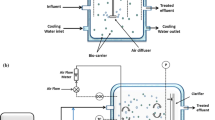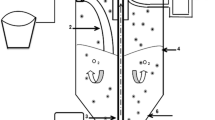Abstract
In this study, the performance of moving-bed biofilm sequencing batch reactor in operating the anaerobic/anoxic/oxic (A2O) process for treatment of wastewaters containing nitrogen and phosphorous was evaluated. For this purpose, a pilot system with two bench-scale sequencing batch reactors with a total volume of 30 L and functional volume of 10 L was used. The installation was elaborated using plexiglass, in which 60% of the functional volume consisted of PVC suspended carriers (Kaldnes K3) with a specific surface area of 560 m2/m3. The independent variables used in this study were hydraulic retention time (HRT) (1.5, 2, 2.5, 3, and 3.5 h) and the initial organic load (300, 500, 800, 1000 mg O2/L). The results showed impressive performance in the case of an initial organic load of 300 mg O2/L and HRT of 3 h with maximum removal of COD and TN, respectively, by 95.1 and 89.8%. In the case of an initial organic load of 1000 mg O2/L and HRT of 3.5 h, the maximum total phosphorus removal was 72.3%. Therefore, according to the analysis of data obtained by different HRTs, it was revealed that the system of A2O has greater efficiency in removing organic matter from wastewater in the shortest possible time.





Similar content being viewed by others
References
Agarwal S, Tyagi I, Gupta VK, Dehghani M, Jaafari J, Balarak D, Asif M (2016) Rapid removal of noxious nickel (II) using novel γ-alumina nanoparticles and multiwalled carbon nanotubes: kinetic and isotherm studies. J Mol Liq 224:618–623
Ahmed M, Idris A, Adam A (2007) Combined anaerobic–aerobic system for treatment of textile wastewater. J Eng Sci Technol 2:55–69
Ardern E, Lockett WT (1914) Experiments on the oxidation of sewage without the aid of filters. J Soc Chem Ind 33:523
Ashrafi SD, Kamani H, Jaafari J, Mahvi AH (2016) Experimental design and response surface modeling for optimization of fluoroquinolone removal from aqueous solution by NaOH-modified rice husk. Desalination Water Treat 57:16456–16465
Balarak D, Jaafari J, Hassani G, Mahdavi Y, Tyagi I, Agarwal S, Gupta VK (2015) The use of low-cost adsorbent (Canola residues) for the adsorption of methylene blue from aqueous solution: isotherm, kinetic and thermodynamic studies. Colloids Interface Sci Commun 7:16–19
Bessbousse H, Rhlalou T, Verchère J-F, Lebrun L (2008) Removal of heavy metal ions from aqueous solutions by filtration with a novel complexing membrane containing poly (ethyleneimine) in a poly (vinyl alcohol) matrix. J Membr Sci 307:249–259
Bina B, Movahedian H, Pourzamani HR (2005) Effect of influent COD/N ratio on nitrification rate in a bench-scale biological reactor. J Water Wastewater 53:30–37
Blaney LM, Cinar S, Sengupta AK (2007) Hybrid anion exchanger for trace phosphate removal from water and wastewater. Water Res 41:1603–1613
Chen H-B, Wang D-B, Li X-M, Yang Q, Luo K, Zeng G-M (2014) Temperature influence on biological phosphorus removal induced by aerobic/extended-idle regime. Environ Sci Pollut Res 21:6034–6043
Chen H-B, Wang D-B, Li X-M, Yang Q, Zeng G-M (2015) Enhancement of post-anoxic denitrification for biological nutrient removal: effect of different carbon sources. Environ Sci Pollut Res 22:5887–5894
Chen H, Liu Y, Ni B-J, Wang Q, Wang D, Zhang C, Li X, Zeng G (2016) Full-scale evaluation of aerobic/extended-idle regime inducing biological phosphorus removal and its integration with intermittent sand filter to treat domestic sewage discharged from highway rest area. Biochem Eng J 113:114–122
Clark T, Stephenson T, Pearce P (1997) Phosphorus removal by chemical precipitation in a biological aerated filter. Water Res 31:2557–2563
Dehghani M, Kermanshahi M (2009) The study of biological efficiency of batch reactor consecutive for Phosphorus removal in wastewater of Shiraz city. In: 12th National conference on environmental health
Esfandyari Y, Mahdavi Y, Seyedsalehi M, Hoseini M, Safari GH, Ghozikali MG, Kamani H, Jaafari J (2015) Degradation and biodegradability improvement of the olive mill wastewater by peroxi-electrocoagulation/electrooxidation–electroflotation process with bipolar aluminum electrodes. Environ Sci Pollut Res 22:6288–6297
Federation WE, Association APH (2005) Standard methods for the examination of water and wastewater. American Public Health Association (APHA), Washington
Geng Z, Hall E, Berube P (2007) Membrane fouling mechanisms of a membrane enhanced biological phosphorus removal process. J Membr Sci 296:93–101
Hassani S, Sepand M, Jafari A, Jaafari J, Rezaee R, Zeinali M, Tavakoli F, Razavi-Azarkhiavi K (2014) Protective effects of curcumin and vitamin E against chlorpyrifos-induced lung oxidative damage. Hum Exp Toxicol, 0960327114550888
Irani V, Seyedsalehi M, Sajadi SAA, Ebrahimiarjestan M (2016) Assessment of the performance of microbial fuel cell (MFC) for the removal of nitrate from water. Indian J Sci Technol 9:1–9
Jaafari J, Mesdaghinia A, Nabizadeh R, Hoseini M, Mahvi AH (2014) Influence of upflow velocity on performance and biofilm characteristics of anaerobic fluidized bed reactor (AFBR) in treating high-strength wastewater. J Environ Health Sci Eng 12:1
Jaafari J, Seyedsalehi M, Safari GH, Ebrahimi Arjestan M, Barzanouni H, Ghadimi S, Kamani H, Haratipour P (2017) Simultaneous biological organic matter and nutrient removal in an anaerobic/anoxic/oxic (A2O) moving bed biofilm reactor (MBBR) integrated system. Int J Environ Sci Technol 14:291–304
Jafari J, Mesdaghinia A, Nabizadeh R, Farrokhi M, Mahvi AH (2013) Investigation of anaerobic fluidized bed reactor/aerobic mov-ing bed bio reactor (AFBR/MMBR) system for treatment of currant wastewater. Iran J Public Health 42:860
Jayaraj SL, Latha P (2010) Upflow anaerobic and aerobic fixed bed reactor for simultaneous COD and nitrogen removal from municipal wastewater. 10th National conference on technological trends 2009 (NCTT09), Trivandrum, Kerala, India
Mousavian S, Takdastan A, Seyedsalehi M, Akhavani S (2016) Determining the kinetic’s coefficients in treatment of sugarcane industry using aerobic activated sludge by complete-mix regime. J Chem Pharm Res 8(4):1342–1349
Naghipour D, Taghavi K, Jaafari J, Mahdavi Y, Ghanbari Ghozikali M, Ameri R, Jamshidi A, Hossein Mahvi A (2015) Statistical modeling and optimization of the phosphorus biosorption by modified Lemna minor from aqueous solution using response surface methodology (RSM). Desalination Water Treat 57:19431–19442
Naghipour D, Gharibi H, Taghavi K, Jaafari J (2016) Influence of EDTA and NTA on heavy metal extraction from sandy-loam contaminated soils. J Environ Chem Eng 4:3512–3518
Rusten B, Hem LJ, Ødegaard H (1995) Nitrification of municipal wastewater in moving-bed biofilm reactors. Water Environ Res 67:75–86
Sadler R, Maetam B, Edokpolo B, Connell D, Yu J, Stewart D, Park M-J, Gray D, Laksono B (2016) Health risk assessment for exposure to nitrate in drinking water from village wells in Semarang, Indonesia. Environ Pollut 216:738–745
Safari GH, Zarrabi M, Hoseini M, Kamani H, Jaafari J, Mahvi AH (2015) Trends of natural and acid-engineered pumice onto phosphorus ions in aquatic environment: adsorbent preparation, characterization, and kinetic and equilibrium modeling. Desalination Water Treat 54:3031–3043
Seyedsalehi M, Goodarzi M, Barzanouni H (2014) Use of carbon in increasing the quality of drinking water-Case study: the wells of Savejbolagh villages. J Biodivers Environ Sci 4(5):102–111
Shahmoradi M, Amin Zade B, Torabian A, Seyedsalehi M (2015) Removal of nitrate from ground water using activated carbon prepared from rice husk and sludge of paper industry wastewater treatment. Arpn J Eng Appl Sci 10(17):7856–7863
Tchobanoglous G, Burton F, Stensel H (2003) Metcalf and Eddy wastewater engineering: treatment and reuse. McGraw Hill, New York, p 384
Tian S, Jiang P, Ning P, Su Y (2009) Enhanced adsorption removal of phosphate from water by mixed lanthanum/aluminum pillared montmorillonite. Chem Eng J 151:141–148
Wang D, Xu Q, Yang W, Chen H, Li X, Liao D, Yang G, Yang Q, Zeng G (2014) A new configuration of sequencing batch reactor operated as a modified aerobic/extended-idle regime for simultaneously saving reactor volume and enhancing biological phosphorus removal. Biochem Eng J 87:15–24
Acknowledgements
The authors would like to express their full gratitude to all who made contribution to conduction of this study. CHN gratefully acknowledge support from the IBISS and MEMENTO projects provided by Innovation Fund Denmark.
Author information
Authors and Affiliations
Corresponding author
Additional information
Editorial responsibility: Binbin Huang.
Rights and permissions
About this article
Cite this article
Seyedsalehi, M., Jaafari, J., Hélix-Nielsen, C. et al. Evaluation of moving-bed biofilm sequencing batch reactor (MBSBR) in operating A2O process with emphasis on biological removal of nutrients existing in wastewater. Int. J. Environ. Sci. Technol. 15, 199–206 (2018). https://doi.org/10.1007/s13762-017-1360-9
Received:
Revised:
Accepted:
Published:
Issue Date:
DOI: https://doi.org/10.1007/s13762-017-1360-9




